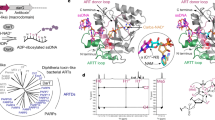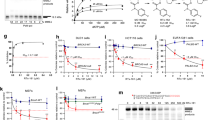Abstract
Anthramycin, an antitumour antibiotic produced by Streptomyces refuineus1, belongs to the pyrrolo(1,4)benzodiazepine antibiotic group2. Antibiotics within this group are potent inhibitors of nucleic acid synthesis because of their ability to form a labile covalent adduct with DNA2–6. The reaction of anthramycin with DNA is unusual in that the rate of adduct formation is slow2,4,5, shows an absolute specificity for deoxyguanosine in a double-stranded template4, and is only stable as long as the secondary structure of DNA is retained6. Experiments using confluent non-dividing human cell lines have demonstrated that while repair-proficient cells are able to remove up to 84% of the adduct within 72 h, xeroderma pigmentosum cells in complementation group A were only able to remove 49% during the same incubation period10. We propose here a Corey, Pauling and Koltun (CPK) molecular model for the anthramycin–DNA adduct in which anthramycin is attached through the 2-amino group of guanine and lies hidden in the narrow groove. Experimental data supporting this model are provided. The model is based on information about the probable covalent binding sites on anthramycin and guanine together with the known crystal structure of anthramyin7.
This is a preview of subscription content, access via your institution
Access options
Subscribe to this journal
Receive 51 print issues and online access
$199.00 per year
only $3.90 per issue
Buy this article
- Purchase on Springer Link
- Instant access to full article PDF
Prices may be subject to local taxes which are calculated during checkout
Similar content being viewed by others
References
Tendler, M. D. & Korman, S. Nature 199, 501 (1963).
Hurley, L. H. J. Antibiotics 30, 349–370 (1977).
Kohn, K. W. in Antibiotics Vol. III (eds Corcoran, J. W. & Hahn, F. E.) 3–11 (Springer, New York, 1975).
Kohn, K. W., Glaubiger, D. & Spears, C. L. Biochim. biophys. Acta 361, 288–302 (1974).
Hurley, L. H., Gairola, C. & Zmijewski, M. Biochim. Biophys. Acta 475, 521–535 (1977).
Hurley, L. H., Allen, C., Feola, J. & Lubawy, W. C. Cancer Res. 39, 3134–3140 (1979).
Mostad, A., Romming, C. & Storm, B. Acta chim. scand. B 32, 639–645 (1978).
Hurley, L. H., Buch, L. C., Zimmer, S. G. & Garner, T. F. Abstr. APhA Acad. pharmac. Sci. Abstr. 13, 8, 112 (1978).
Glaubiger, D., Kohn, K. W. & Charney, E. Biochim. biophys. Acta 361, 303–311 (1974).
Hurley, L. H., Chandler, C., Garner, T. F., Petrusek, R. & Zimmer, S. G. J. biol. Chem. 254, 605–608 (1979).
Scudiero, D., Henderson, E., Norin, A. & Strauss, B. Mutation Res. 29, 473–488 (1975).
Karran, P., Higgins, N. P. & Strauss, B. Biochemistry 16, 4483–4490 (1977).
Vogt, V. Eur. J. Biochem. 33, 192–200 (1973).
Lown, J. W. & Joshua, A. V. Biochem. Pharmac. 28, 2017–2026 (1979).
Author information
Authors and Affiliations
Rights and permissions
About this article
Cite this article
Hurley, L., Petrusek, R. Proposed structure of the anthramycin–DNA adduct. Nature 282, 529–531 (1979). https://doi.org/10.1038/282529a0
Received:
Accepted:
Published:
Issue Date:
DOI: https://doi.org/10.1038/282529a0
This article is cited by
-
Synthetic studies toward novel pyrrolobenzodiazepine–coumarin hybrids
Chemistry of Heterocyclic Compounds (2020)
-
Analytical Techniques Used to Detect DNA Binding Modes of Ruthenium(II) Complexes with Extended Phenanthroline Ring
Journal of Fluorescence (2017)
-
The newer synthetic strategies for DNA binding pyrrolobenzodiazepine antibiotics (review)
Chemistry of Heterocyclic Compounds (1998)
Comments
By submitting a comment you agree to abide by our Terms and Community Guidelines. If you find something abusive or that does not comply with our terms or guidelines please flag it as inappropriate.



